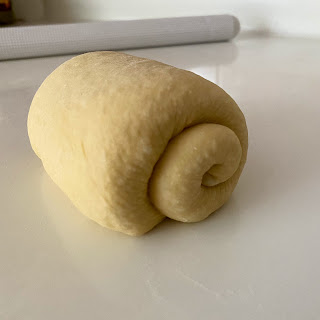Yield: Twin loaves in one pan
Pan size: 21x13x10 cm 1.5L
Raw dough weight: 602g
Baking temperature: Preheat oven to 190℃, lower rack, bake at 180℃ for 15 minutes, reduce to 170℃ for 15 minutes, turn off oven and continue to bake for 5 minutes.
Ingredients
220g bread flour
45g superfine wholegrain flour
35g raw sugar
2g instant dry yeast (increase the yeast to 3g for a faster proofing time)
50g natural yeast, 100% hydration *
38g yudane dough ^
60g carrot juice
110g milk, cold
15g water, cold, to be added depending on dough condition
3g low-sodium salt
30g unsalted butter, softened
3g unsalted butter, melted as butter wash
* 50g natural yeast can be replaced by 25g each of bread flour and water + 1/8 tsp instant dry yeast. Let the mixture stands for about 1 hour or till double in volume, before use. You can also keep the mixture in the fridge overnight and thaw it for 1 hour before use.
^ 38g yudane dough is prepared by combining 20g of bread flour with 19g of very hot or boiling water into a sticky dough. Wrap the yudane dough in cling wrap, cool down before chilling in the fridge overnight. You may refer to Yudane Milk Bread for a pictorial illustration.
Directions
Knead the dough using your preferred method till reaching window pane stage.
1. Mix dried ingredients except the salt, in a big mixing bowl followed by the natural yeast, yudane dough and the wet ingredients, except the unsalted butter.
 |
| window pane stage |
3. Shape the dough into a ball, spray some water over, cover with a lid, and let the dough proof for about 100 minutes, or till double in size.
 |
| End of first proofing |
4. Invert out the dough onto a floured worktop.
 |
| End of 15-minute resting |
5. Roll out the dough to a thickness of about 1 cm.
 |
| End of second proofing |
7. Start to preheat the oven to 190℃ for about 10 minutes.
Place the stencils over the surface of the dough.
If you are not using stencils, just dust a thin layer of bread flour over the dough.
Lightly dust some bread flour over.
Remove the stencils, and dust another layer of bread flour over.
8. Place the pan at lower rack of a preheated oven, reduce the temperature to 180℃, and bake for 15 minutes. Further reduce the temperature to 170℃, and bake for 15 minutes. Turn off the oven heating, and continue to bake for 3 to 5 minutes, or till the crust turns golden brown.
9. Remove the bread from the pan immediately after leaving the oven.
Cool over a wire rack before slicing.








































No comments:
Post a Comment
I love seeing your comment and sharing it with other readers. Your comment would be published after moderation. Thank you :)